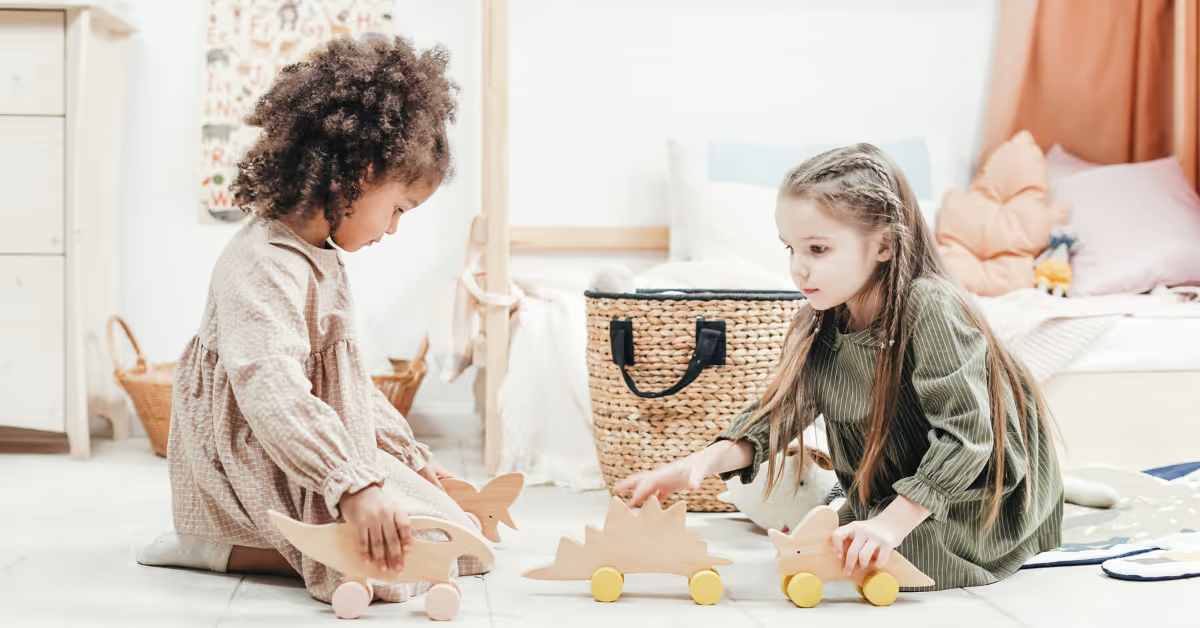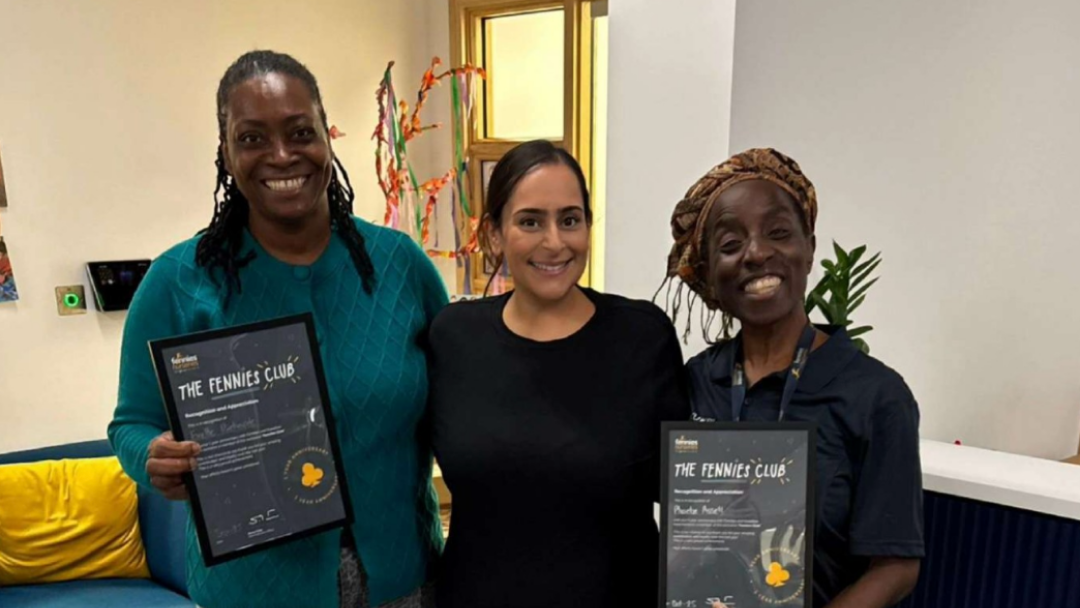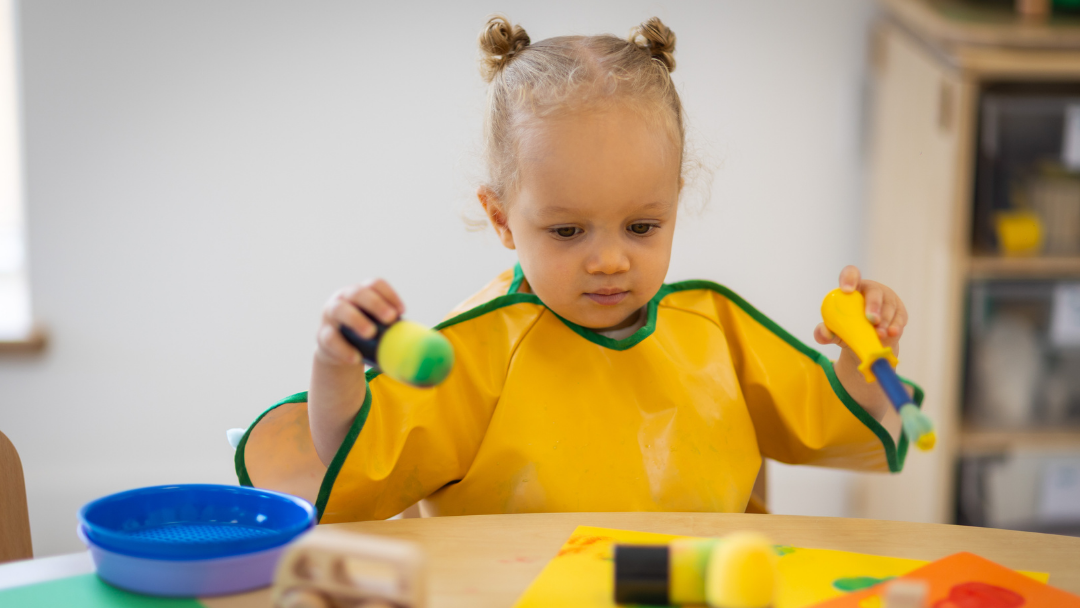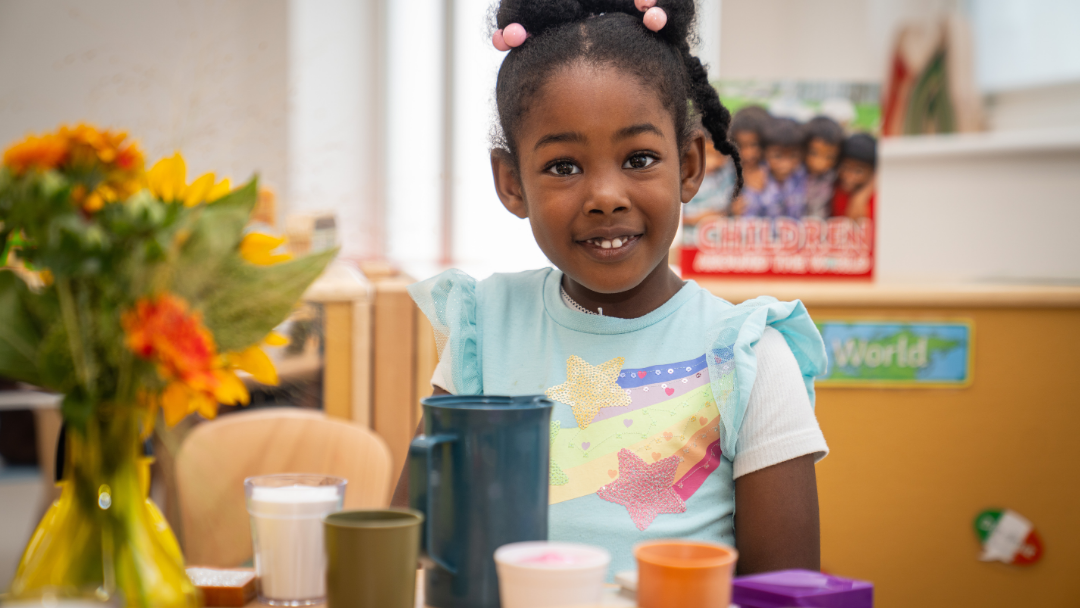Buying children’s toys– is it a question of short-term pain versus long-term gain? Sam Wass delves deeper into the toy box.
The types of toys that are popular in children’s play have gone full circle. From the wooden toys that were popular a hundred or so years ago to plastic toys that were almost universal when I was a child in the 1980s.We’re now suddenly back at a stage where wooden toys seem to be everywhere!
Everybody seems to be buying and making toys from natural materials like wood and in natural colours, rather than made from plastic, in bright colours. But is this just a trend? Or is there actual scientific evidence behind it? Well – it’s a little bit of both.
There are a few different reasons why parents might go for wooden toys over plastic ones, from worries about the safety of plastic toys to concerns about their environmental impact. But there are also more subtle reasons that I think are super important, including how children play differently with wooden toys vs plastic ones and how this affects their long-term development.
Are wooden toys safer or more environmentally friendly?
The first question is one of safety. Arguments against plastic toys have been made on this basis for a few different reasons. The first reason is that many plastic toys contain substances, like BPA and phthalates, which can be directly toxic for children. Although there is a lot online about this, it’s honestly the point that I’d pay the least attention to.
Since concerns on this point were first aired back in 2008, BPA has been generally phased out – at least by all reputable manufacturers. (You still need to watch for the cheap ones, though - a good watchword is that if it seems suspiciously cheap, then be suspicious!) But a lot of the alarm-raising articles you find online will ignore important facts such as that, even these chemicals can be carcinogenic, we almost all have trace levels of these chemicals in us anyway. Importantly, there is no evidence (that I’ve seen anyway) that playing with toys can increase your levels of BPA and phthalates. So as long as you’re buying good quality toys, then you should be fine, whether they're wooden toys or plastic toys.

There is also, though, the wider environmental element to be considered. Because many plastic toys are made from oil, they are far less sustainable than toys made from renewable materials like wood (as long as the wood is sustainably sourced – look for this certification, for example).
Timeless wooden toys also tend to be basically indestructible and can be passed down through future generations, which means that you don’t need to buy new ones so often. And when you are finished with them they will eventually biodegrade (unlike plastic toys), meaning they can be disposed of in a much safer way.
Do wooden toys connect children to nature?
Although the evidence against plastic toys being dangerous for children may not be the most reliable, I do, though, believe some of the more substantial, indirect evidence about how wooden toys can help support children’s development.
For example, there is strong evidence which suggests that actually being outside and connected to nature has a variety of beneficial effects for children, and there’s even evidence that simply showing children pictures of nature when indoors can improve their concentration and learning.
As well as this, there’s also research stating we might find it easier to process natural textures, like wooden toys, because as humans, we’ve had more time as a species to practice processing them. This could also be why people often find being surrounded by natural textures more relaxing and could have the same effect when children play with toys made from these natural materials.

But when it comes to the developmental side of things, there isn’t yet, to my knowledge, any evidence that actually playing with toys made from natural materials directly affects children differently from playing with plastic toys. But there is indirect evidence around how this is affected by a child's age...
Are wooden toys or plastic toys better for older children?
One thing that does potentially make an important difference to a child’s development is that different types of toys ‘want’ to be played with in very different ways. Compare, for example, two toys – let’s call them Toy A and Toy B (without mentioning any particular manufacturer’s names!). Toy A is a board with lots of buttons on it that go whirr and buzz when you press them. And Toy B is a simple wooden horse.

How would a child behave differently around these two toys when they’re playing with them? The first big difference between these two is that Toy A is interactive, whereas Toy B isn’t. When you press a button on Toy A something happens; but when you touch the wooden toy, nothing happens. Whether this is a good thing or not, is where it gets more complicated! And it depends, probably, on the age of the child.
For younger children, it might be helpful to learn through a simple type of cause-and-effect mechanism. It might also help to build up connections that help the cross-talk between different areas of a child’s brain. This is why, when you give simple wooden toys, like Toy B, to a young child, they’ll bash it up and down on a table to make a noise – which is basically like trying to turn a wooden horse into a press-a-button to make a noise-type toy! Every time I bash it, I make a noise. Older children, though, are past the age for this simple cause-and-effect learning, so they wouldn’t have so much to gain from that. And reflecting that, they’ll naturally play with a wooden horse very differently.
How do wooden or plastic toys keep children’s attention?
The other big difference between wooden toys and interactive toys, though, is that Toy A makes noises and flashes lots of lights at you, whereas Toy B doesn’t. This is the bit about them that really bothers me, as someone who researches how concentration develops in children. And here’s why…
Top-down and bottom-up attention
Basically, to cut a long story short, there are two different ways in which children can pay attention. Our attention can either be ‘pulled in’, automatically, by things in the outside world – like things that beep and whirr, that are hard to ignore even if we’re trying not to pay attention to them. This is called ‘bottom-up’ attention.
Or, our attention can be voluntarily directed, when we choose effortfully to pay attention to one thing and not something else. (When I’m doing a talk about this, I’d normally ask audiences to try a short meditation exercise to shift the focus of their awareness around the body, just to get a feel for the idea that you can voluntarily control your attention.) This type of attention is called ‘top-down’ attention, for reasons I talk about here.
Of the two, it’s definitely the latter type of attention – the voluntary kind – that is the ‘good’ type of attention – that we want to be encouraging and developing in children.
How different toys require different types of attention

Toys that beep, whirr, or flash are carefully designed to hold and glue children’s attention by using these ‘bottom-up’, or ‘pulled-in’ attention mechanisms. Because they do this, they don’t develop a child’s top-down attention! They actively make themselves hard not to pay attention to. (Something that personally drives me mad when my kids are playing with something beeping and whirring in the back seat of our car, the noises are designed to be so hard to ignore!)
Classic wooden toys are very different. These types of toys don’t do anything to try to ‘pull’ your attention in. It’s only if a child picks up the toy and chooses to engage with it, whether it’s by starting to tell a story, or making something from it, that it becomes engaging at all. So essentially, they have to put something into it to get anything out.
This exact same argument, by the way, can also be made to explain why watching TV might not be great for a child’s concentration. Again, it’s because the TV has a lot of movement in it, which automatically ‘pulls in’ their attention and makes it easy to pay attention to, which means that children who spend a lot of time watching TV don’t ever get to practice ‘real’ concentration.
Are simple wooden toys better for imaginative play?
The final difference between Toy A and Toy B is that Toy A can basically only be played with in one way. Your child can mash the buttons to make a noise, but then that’s it — there’s not much they can do beyond that.

Whereas with Toy B, (and most other wooden toys) there isn’t just one particular thing your child might do with it. They might put it in a farmyard with other animals, stick some blu tack on its nose and turn it into a unicorn, or ride it off on a big adventure to rainbow land – it’s up to them! Again, this matters because with Toy B (and other wooden toys), it’s what the child puts into the play session that determines how much they get back.
Children can keep playing with simpler wooden toys for as long as they have ideas and with children’s imagination, this will most likely be a very long time! Whereas for Toy A you only need to mash the buttons for it to start entertaining you. But there’s only one thing that you can do with it, over and over again.
Should I choose wooden toys or plastic toys?
Basically, what I’ve been saying in this article is that the question of which toy to buy your child often comes down to short-term pain vs long-term gain!
In the short term, young children will probably find it easier to pay attention to something that beeps and whirrs - whereas wooden toys might be harder for them to pay attention to keep focused on. This interactivity will help them in some ways when they’re still learning cause and effect, but not beyond that.
For older children, I’d argue that these simple wooden toys are harder for them to engage with. For example, they might need more help from you to start with in thinking up ideas for things to do with them. Long term, though, they’re likely to be more beneficial for their development.
The more practice your child can get at staying focused, from an early age, on something that's not ‘trying’ to attract their attention, the better. If they have to invest something of themselves (for example, by making up a story) in order to get something out of the play, then that’s great. This is the type of play that lays excellent foundations for future learning and for concentration in school.
FAQ
Subscribe to our newsletter
Stay up to date with Fennies news






.png)



